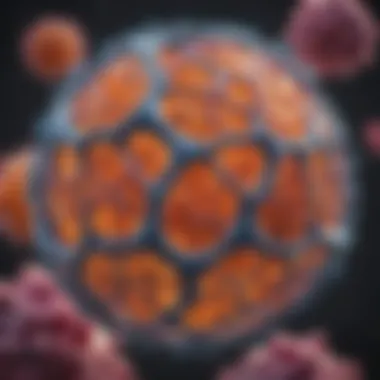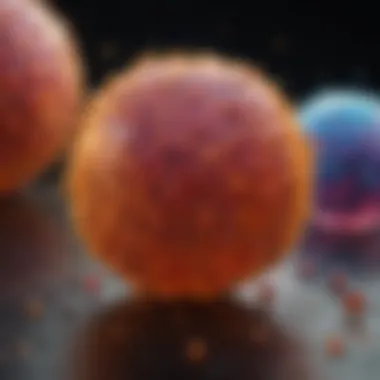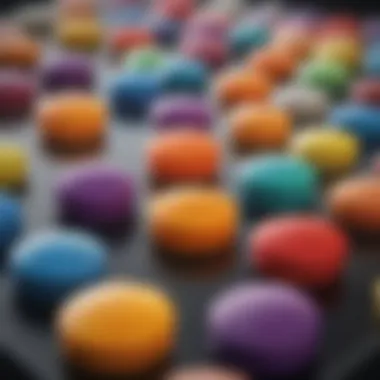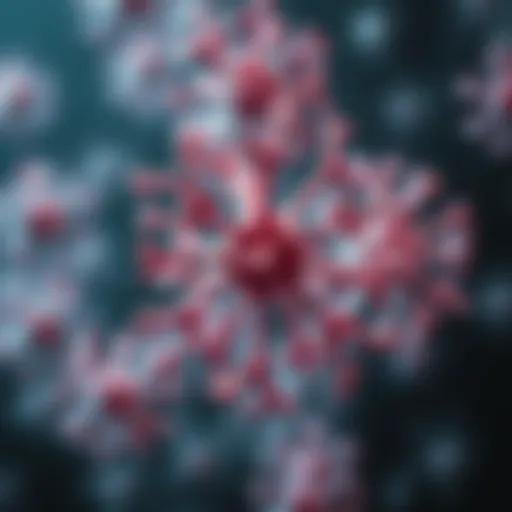Exploring Cell Permeable Dyes: Mechanisms and Uses


Intro
Cell permeable dyes represent a pivotal advancement within biological research and cellular imaging. These compounds possess unique chemical properties that allow them to cross cell membranes, enabling scientists to monitor cellular processes with precision. Understanding the mechanisms and applications of these dyes is vital for various scientific disciplines, from developmental biology to pharmacology.
The significance of cell permeable dyes lies not only in their ability to visualize live cells but also in their crucial role in understanding complex biological systems. This article examines their chemical structures, permeation mechanisms, and broad range of applications. By shedding light on how these dyes function at a molecular level, we provide researchers with insights that can inform future studies and therapeutic interventions.
Research Highlights
Key Findings
- Chemical Properties: Cell permeable dyes are characterized by their lipophilicity, allowing them to dissolve in cell membranes. Their design often incorporates functional groups that enhance membrane diffusion.
- Mechanisms of Action: These dyes can enter cells passively or via facilitated diffusion. Factors such as molecular size, charge, and solubility significantly influence their permeability.
- Applications in Cellular Imaging: Dyes like Calcein AM and Ethidium Bromide are extensively used for assessing cell viability and apoptosis. These applications highlight the crucial role of cell permeable dyes in real-time studies of cellular dynamics.
Implications and Applications
Cell permeable dyes have a vast array of implications in research:
- Fluorescence Microscopy: Researchers use these dyes for high-resolution imaging, allowing detailed observation of cellular organelles.
- Drug Development: They aid in evaluating drug efficacy by providing insights into drug absorption and cell interaction.
- Disease Mechanism Studies: By tracking cellular events, these dyes contribute to understanding diseases at the cellular level, paving the way for novel therapeutic approaches.
Cell permeable dyes serve as a crucial tool in the arsenal of researchers aiming to decipher complex biological processes, significantly advancing the field of cellular biology.
Methodology Overview
Research Design
Emphasizing the importance of a systematic approach, studies using cell permeable dyes often follow a structured design. This involves selecting appropriate dyes based on the specific biological question and the properties of the cell type being studied.
Experimental Procedures
- Cell Preparation: Cells are cultured under appropriate conditions.
- Dye Selection: The choice of dye relies on factors such as cell type, permeability, and the intended measurement (e.g., membrane integrity).
- Dye Application: Dyes are introduced to the culture medium, allowing time for penetration.
- Imaging: Cells are observed under fluorescence microscopy, typically using specific filters that match the dye's emission spectrum.
Through meticulous design and careful execution, researchers can gain valuable insights into cellular functions, making the study of cell permeable dyes not only impactful but necessary for advancing scientific knowledge.
Foreword
Cell permeable dyes play a crucial role in the realm of biological research and diagnostics. Their ability to traverse cellular membranes facilitates a deeper understanding of cellular processes, dynamics, and interactions. An expansive exploration of these dyes reveals their significance in various applications, ranging from fluorescence microscopy to drug development. In this article, we will discuss the defining characteristics, mechanisms of action, and historical context behind cell permeable dyes, laying a foundation for their importance in advancing scientific knowledge.
Definition and Importance of Cell Permeable Dyes
Cell permeable dyes are small, typically low molecular weight compounds that can easily diffuse across cellular membranes. This property makes them invaluable for studies relating to cellular functions, tissue analysis, and live-cell imaging. They allow researchers to visualize cellular structures and processes in real time, which is essential for studying the behavior of cells under various conditions.
The primary importance of these dyes stems from their wide-ranging applications. For instance, they are used in mechanistic studies to understand how cells respond to stimuli or stress, aiding in the diagnosis of diseases. Moreover, they are fundamental in drug discovery, helping in the evaluation of drug delivery systems. With applications in both basic research and clinical settings, their relevance cannot be overstated.
Historical Context and Development
The journey of cell permeable dyes began in the mid-20th century when scientists sought more effective methods for staining cells for visualization. Early dyes were primarily used for histological purposes, yet they often lacked specificity or could not penetrate living cells. The advent of fluorophores marked a significant leap in this field, providing tools that could tag specific cellular components and functions.
As research progressed, developments in organelle-specific dyes and enhanced fluorescent properties catalyzed the advancement of imaging technologies. For example, the introduction of Calcein-AM in the 1990s highlighted a pivotal moment, as it allowed researchers to perform live-cell imaging more effectively. Over time, innovations in chemical synthesis and dye design have led to an array of options, enabling targeted studies across differing biological systems.
In summary, understanding the historical development of cell permeable dyes provides insight into how they became integral to contemporary research. Their evolution reflects the ongoing quest for better tools in the biological sciences, illustrating the interplay between chemistry and biology in advancing scientific comprehension.
Chemical Properties
Chemical properties of cell permeable dyes are crucial for understanding their functionality and applications in biological contexts. The ability of a dye to penetrate cellular membranes is fundamentally reliant on its chemical structure and characteristics. This section provides insight into the molecular structure of these dyes and addresses the importance of solubility and stability for effective usage in various biological research.
Molecular Structure and Characteristics
The molecular structure of cell permeable dyes plays a significant role in dictating their permeability and overall behavior when introduced to biological systems. Generally, these dyes have small molecular weights and are neutrally charged or possess a balance of ionic characteristics that allow them to traverse lipid bilayers more easily.
Commonly, cell permeable dyes are composed of a hydrophobic backbone, which facilitates interaction with the lipid portions of cellular membranes. For example, dyes such as Calcein or DiO feature long hydrocarbon chains, enhancing their ability to blend into the hydrophobic environment of the cell membrane.
The presence of functional groups, like amines or carboxylates, can modulate the dye's interaction with biological molecules and influence cellular uptake. As such, a balance of hydrophobic and hydrophilic segments in the molecular design is essential for optimizing the performance of these dyes.


Solubility and Stability
Solubility and stability are vital parameters when considering the application of cell permeable dyes in research. A dye's solubility in aqueous solutions dictates not only its effectiveness in live-cell imaging but also its compatibility with various biological assays. Generally, more soluble dyes ensure better distribution within the cellular environment, granting clearer and more reliable imaging results.
The stability of these dyes in biological conditions is equally important. Dyes need to maintain consistent performance under varying temperatures and pH levels that often occur in biological systems. Degradation of a dye can lead to unreliable results or misinterpretation of cellular processes.
For instance, some dyes are prone to photobleaching, losing their fluorescence when exposed to light over time. Strategies to enhance dye stability include the development of more robust compounds that can withstand environmental stressors without significant alteration of their properties.
"The effectiveness of cell permeable dyes hinges not just on their ability to enter cells, but also on their chemical properties that facilitate their stability and solubility in diverse environments."
Mechanisms of Action
Understanding the mechanisms of action for cell permeable dyes is crucial for their application in both research and clinical contexts. These mechanisms provide insights into how these dyes can efficiently traverse cellular membranes, thereby facilitating a range of biological experiments. Effective permeation is essential in allowing scientists to visualize cellular processes, assess cell viability, and even enhance drug delivery systems. By comprehending the fundamental principles that govern the action of these dyes, researchers can better design experiments and interpret results.
Transport Mechanisms Across Cellular Membranes
Transport mechanisms are vital to the functionality of cell permeable dyes. These mechanisms determine how effectively a dye can enter a cell and interact with intracellular components. The predominant transport methods include passive diffusion, facilitated diffusion, and sometimes active transport.
- Passive Diffusion: This occurs when a substance moves from an area of higher concentration to an area of lower concentration without the need for energy input. Most lipophilic dyes utilize this mechanism, aligning their compatibility with the lipid bilayer of cell membranes.
- Facilitated Diffusion: In this case, specific transport proteins assist in moving larger or polar molecules across the membrane, without expending ATP energy. This method is often more efficient for certain dye types, ensuring rapid entry as they bind selectively to transport proteins on the membrane.
- Active Transport: Although less common for dyes, some may utilize cellular energy to cross membranes. This is particularly significant when the dye's concentration outside the cell is lower than inside, requiring the cell to expend energy to take in the dye.
Factors Affecting Permeability
The permeability of cell permeable dyes is influenced by several factors. Understanding these can aid in optimizing dye selection for specific experiments or applications.
Cell membrane composition
Cell membrane composition plays a crucial role in determining permeability. A membrane's lipid bilayer, primarily composed of phospholipids, can create barriers for hydrophilic molecules while allowing lipophilic substances to pass through.
- Key Characteristic: The fluidity of the membrane is significant. A more fluid membrane, composed of unsaturated fatty acids, tends to allow greater permeability.
- Unique Feature: Phospholipids can vary between cell types, which makes some cells more permeable to certain dyes than others. For example, neuronal cell membranes may exhibit higher permeability due to their unique composition, which can include varying amounts of cholesterol.
Concentration gradients
Concentration gradients affect the movement of dyes across membranes significantly. A dye will move from an area of high concentration to one of low concentration until equilibrium is reached, which is critical for experiments involving kinetics.
- Key Characteristic: The steeper the concentration gradient, the more rapid the diffusion.
- Unique Feature: This feature must be carefully controlled in experiments to obtain consistent and interpretable results. If concentrations are balanced too quickly, the effectiveness of the experiment may be compromised, requiring additional adjustment periods for accurate readings.
Temperature effects
Temperature influences the kinetic energy of molecules. As temperature rises, the movement of molecules increases, impacting diffusion rates. For cell permeable dyes, temperature plays a fundamental role in their uptake and effectiveness.
- Key Characteristic: Higher temperatures typically enhance permeation rates due to increased molecular activity.
- Unique Feature: However, excessive temperatures may also induce cellular stress or even damage, impacting results. Thus, finding an optimal temperature for experiments is essential for reliable data collection.
An optimal balance of these factors ensures that cell permeable dyes can be effectively utilized in various experimental settings, aiding the advancement of biological research and its applications.
Applications in Biological Research
The examination of cell permeable dyes plays a crucial role in biological research. These dyes have become vital tools in various experimental setups, enabling researchers to study cellular phenomena with high precision. Their ability to easily penetrate cell membranes allows scientists to visualize and quantify cellular processes in real-time. The applications of these dyes are diverse and extend from fundamental research to clinical diagnostics.
Fluorescence Microscopy Techniques
Fluorescence microscopy is one of the primary techniques that benefits from the use of cell permeable dyes. This method relies on the emission of light by the dyes upon excitation. The advantage of utilizing these dyes in fluorescence microscopy is their capability to selectively stain specific cellular components. For instance, dyes like DiO and DiI label lipids, whereas Calcein-AM helps in imaging live cells by indicating cell viability.
The process allows researchers to obtain high-resolution images, revealing intricate details of cellular structures. Advanced techniques, such as confocal microscopy, can further enhance the imaging quality by providing optical sectioning. Nevertheless, choosing the right dye is imperative; considerations include excitation/emission spectra, cellular localization, and potential phototoxicity.
Live-Cell Imaging
Live-cell imaging is another essential application where cell permeable dyes shine. This technique allows researchers to observe dynamic cellular processes over time. By using dyes that can integrate into live cells without affecting their viability, scientists can monitor changes in cellular morphology, movement, and interactions in real time.
For example, CellTracker dyes are a popular choice in this area. They can bind to cellular components and remain within the cells, providing a way to trace cell lineage and behavior in various experimental conditions.
However, effectively implementing live-cell imaging requires careful optimization. Factors such as light exposure, dye concentration, and duration of observation are critical to minimize photodamage while still obtaining noise-free data.


Cell Viability Assays
Cell viability assays are pivotal in understanding the effects of drugs and treatments on cell health. Cell permeable dyes such as MTT and Trypan Blue are extensively used to assess cell viability and proliferation. MTT assay, for instance, measures the metabolic activity of viable cells; it transforms into a colored formazan product within living cells, which can be quantified via spectrophotometry.
On the other hand, Trypan Blue serves as a simple dye exclusion assay where live cells fail to uptake this dye, thus appearing clear under a microscope, while dead cells take it up and appear blue.
In selecting an assay, researchers must consider the specificity and the limitations of each dye. For example, Trypan Blue may yield false positives if not distinguished properly, whereas MTT requires additional steps for quantitative measurement.
In summary, cell permeable dyes have revolutionized biological research by enabling fluorescence microscopy, live-cell imaging, and various cell viability assays. Their ability to inform on cellular health and processes aids significantly in advancing our understanding of biology.
In essence, mastering the use of cell permeable dyes is essential for students and professionals alike. Learning about their mechanisms of action and applications allows for more insightful experiments and findings in the domain of cellular biology.
Clinical Implications
Understanding the clinical implications of cell permeable dyes is essential for professionals across various fields of biological research, drug development, and diagnostics. These dyes are critical in bridging the gap between laboratory experiments and clinical applications. They allow for the visualization and tracking of cellular processes in real-time, enhancing the study of disease mechanisms and the effects of therapeutic agents.
Cell permeable dyes serve multiple roles in clinical settings. The advantages include greater specificity in targeting cells of interest, improved identification of cellular changes, and more efficient evaluation of treatment efficacy. The ability to assess drug behavior in live cells opens up pathways for tailored medical interventions, particularly in oncology and chronic diseases.
Role in Drug Development
The role of cell permeable dyes in drug development cannot be understated. They aid in understanding how new drug compounds penetrate cellular membranes and interact with their targets. By using these dyes in preclinical studies, researchers can visualize the cellular uptake and distribution of therapeutic agents. This insight is crucial for optimizing drug formulation and increasing the likelihood of clinical success.
Moreover, cell permeable dyes enhance screening processes in drug discovery. Combining high-throughput screening methods with these dyes facilitates rapid assessment of numerous compounds, thus accelerating the identification of promising drug candidates. The fine line between drug effectiveness and toxicity often determines the success of treatments, and utilizing these dyes helps elucidate safety profiles early in the development process.
Potential in Disease Diagnosis
The potential of cell permeable dyes in disease diagnosis is another area of significance. These dyes can aid in the early detection of pathological conditions by targeting cellular changes associated with various diseases. Utilizing fluorescence-based approaches, clinicians can observe biomarkers indicative of disease states, facilitating timely interventions.
In conditions such as cancer and neurodegenerative diseases, the application of cell permeable dyes provides critical insights into cellular health and viability. By employing these tools, researchers can develop diagnostic assays that offer higher sensitivity and specificity than traditional methods.
Furthermore, with the advent of personalized medicine, the ability of cell permeable dyes to distinguish between healthy and diseased cells stands to improve diagnostic accuracy. This precision contributes to better patient outcomes by enabling tailored treatment strategies that target individual cellular profiles.
"Cell permeable dyes are not just tools for visualization; they are integral in the rapidly evolving landscape of diagnostic technologies, offering hope for more effective disease management."
Challenges and Limitations
Understanding the challenges and limitations related to cell permeable dyes is crucial for researchers and practitioners in biological fields. These issues can significantly impact the effectiveness and reliability of experimental outcomes. Addressing these limitations can lead to improvements in research methodologies and applications.
Toxicity Concerns
One of the most pressing challenges associated with cell permeable dyes is their potential toxicity. Many of these dyes, while effective in revealing cellular processes, may exhibit adverse effects on cell health. High concentrations of dyes can lead to cytotoxicity, where cells may undergo apoptosis or necrosis.
Research has indicated that certain dyes like propidium iodide and ethidium bromide can compromise cell integrity at elevated concentrations. It is vital to evaluate the dosage and exposure time when applying these dyes to ensure they do not interfere with the biological processes under study.
Moreover, some dyes may not only affect the target cells but also influence neighboring cells. This poses a significant challenge in live-cell imaging, where any disruption can lead to inaccurate data.
- Key considerations for managing toxicity include:
- Performing dose-response studies to determine the minimal effective concentration.
- Implementing wash-out protocols to mitigate sustained exposure.
- Choosing dyes with better toxicity profiles, like Calcein-AM, which are less harmful than others.
Specificity and Selectivity Issues
Another significant challenge is the lack of specificity and selectivity of some cell permeable dyes. While these dyes can effectively enter cells, they may also label unintended targets, leading to false positives or misinterpretation of results. This can complicate the analysis of cellular events, particularly in heterogeneous cell populations where distinction between different cell types is required.
For example, some fluorescent dyes can bind to nucleic acids, but they may also interact with other cellular components, such as proteins and lipids, which can obscure results. To enhance specificity, researchers might need to use dyes that are tailored for certain cellular structures or functions.
- Strategies to improve specificity include:
- Utilizing dyes with high affinity for specific targets, such as Hoechst dye for chromatin.
- Employing combination assays with antibodies or other markers that enhance specificity.
- Calibrating experimental conditions (pH, ionic strength) to optimize dye-target interactions.
In summary, the challenges of toxicity and selectivity are significant when it comes to cell permeable dyes. A thoughtful approach considering these insues can improve experimental outcomes and ensure that findings are both reliable and meaningful. Understanding these factors also enhances the efficacy of these important tools in biological research.


Current Trends and Innovations
The field of cell permeable dyes is experiencing significant evolution. These developments not only enhance their utility in research but also have far-reaching implications for clinical applications. Current trends focus on improving the efficiency, specificity, and safety of these dyes. This section delves into two major areas: emerging technologies in imaging and advancements in dye chemistry.
Emerging Technologies in Imaging
Innovations in imaging technologies are transforming how researchers use cell permeable dyes. High-resolution imaging techniques, such as super-resolution microscopy, enable scientists to observe cellular processes at unprecedented levels of detail. These technologies increase the potential of cell permeable dyes to provide accurate and dynamic information about cellular behavior in real-time.
New types of imaging systems, like fluorescent lifetime imaging microscopy (FLIM) and Stimulated Emission Depletion (STED) microscopy, offer improved sensitivity and resolution. These methods help in visualizing protein interactions and cellular structures with remarkable clarity. As these technologies advance, the integration of multi-modal imaging approaches is becoming more prevalent. This synergy allows for simultaneous measurements of different cellular components, enhancing the value of cell permeable dyes in complex biological systems.
Furthermore, advancements in software and computational tools for image analysis are also notable. Sophisticated algorithms can now process vast datasets quickly, providing insights that were previously time-consuming or infeasible. The combination of advanced imaging techniques and sophisticated data analysis is propelling research forward, allowing scientists to explore the intricate workings of cell biology more effectively.
Advancements in Dye Chemistry
The chemistry behind cell permeable dyes is under constant evolution. Researchers are exploring novel synthetic pathways to develop dyes with improved properties. These advancements in dye chemistry aim to enhance the stability, brightness, and specificity of fluorescent dyes used in cellular studies. For instance, newer classes of dyes, like organic fluorophores and quantum dots, demonstrate remarkable photostability and allow longer imaging sessions without signal degradation.
Designing dyes that can target specific cellular processes also remains a priority. By tailoring the molecular structure of dyes, scientists can create tools that selectively mark various structures, such as organelles or specific protein interactions. This specificity is crucial for accurate interpretations in complex biological systems.
Another essential aspect is reducing potential toxicity. Many innovative dyes are being designed to minimize cellular stress and maximize viability during experiments. Reducing cytotoxic effects is critical for applications in live-cell imaging and assays.
"The continued innovation in dye chemistry expands the horizons of cellular studies, enabling researchers to unravel complex biological dynamics with greater precision."
In summary, current trends and innovations in cell permeable dyes are reshaping the landscape of biological research. As technologies in imaging and advancements in dye chemistry progress, the potential for these dyes to contribute to scientific knowledge continues to grow.
Future Directions
The future directions for cell permeable dyes hold immense potential in various scientific fields. As technology progresses, the demand for innovative solutions in cellular imaging and research grows. Understanding the future trajectories can shape new methodologies and broaden the applications of these dyes.
Research Opportunities in New Applications
There are numerous research avenues emerging in the field of cell permeable dyes. These dyes can be employed in areas such as cancer research, where they assist in visualizing tumor microenvironments. Additionally, their utilization in neuroscience can lead to enhanced understanding of synaptic functions and neuronal activities.
The development of novel dyes that can simultaneously target multiple pathways is another opportunity. For instance, creating dyes that highlight cell death and apoptosis processes could give researchers deeper insights into disease progressions. This multifaceted approach can support advances in therapeutic strategies, especially in personalized medicine.
New applications also include:
- Tracking cellular responses to drugs in real-time, providing dynamic data.
- Studying intracellular trafficking to understand how proteins and other molecules move within cells.
- Investigating metabolic processes in live cells to gain insights into energy dynamics.
These advancements could lead to designing more effective diagnostic tools in clinical settings.
Integration with Other Technologies
Integrating cell permeable dyes with other emerging technologies represents a significant frontier for exploration. For example, coupling these dyes with CRISPR technology can facilitate live-cell imaging of gene editing processes. This can help researchers monitor the efficiency of modifications in real time, which is crucial for advancing genetic studies.
Moreover, combining dyes with artificial intelligence systems could enhance data interpretation. AI can analyze complex imaging data rapidly, offering insights that may be overlooked by human observers. This would not only improve research outcomes but could also streamline workflows in laboratories.
Another promising direction is the incorporation of dyes in nanoparticle systems. This combination can enhance the delivery of therapeutics, granting higher specificity and lower toxicity. It represents a crucial step toward more effective treatments, particularly in oncology.
In summary, the future for cell permeable dyes is rich with opportunity. Expanding their application scope, coupled with integration into other technologies, stands to revolutionize biological research and its applications in the clinical sphere.
Ending
The conclusion of this article on cell permeable dyes serves as a vital section, underscoring key elements, benefits, and considerations relevant to the overall discourse. It synthesizes the insights gained from the earlier sections, thereby offering a comprehensive overview of the role and implications of these dyes in both research and clinical settings. Recognizing their significance in advancing cellular studies cannot be overstated. These dyes have transformed the landscape of biological research by enabling scientists to visualize and analyze cellular processes with remarkable clarity and accuracy.
Summary of Key Insights
In summary, cell permeable dyes are instrumental in numerous scientific fields. The most critical insights include:
- Mechanisms of Action: Understanding how these dyes cross cellular membranes is essential for optimizing their use in various studies.
- Applications: From fluorescence microscopy to cell viability assays, their versatility enhances research capabilities.
- Challenges and Limitations: Awareness of toxicity and specificity issues is crucial in the application of these dyes to avoid misleading results.
Furthermore, as technology evolves, there is continuous improvement in the chemical properties of these dyes, expanding their applicability in research and clinical realms.
Final Thoughts on the Impact of Cell Permeable Dyes
"Cell permeable dyes not only illuminate the shadows of biological processes but also delineate pathways for future scientific exploration."
The exploration of new applications and integration with other technologies is vital. This ongoing evolution assures that the relevance of cell permeable dyes continues to grow, making them a focus of future research endeavors and enhancing our grasp on biological sciences.



